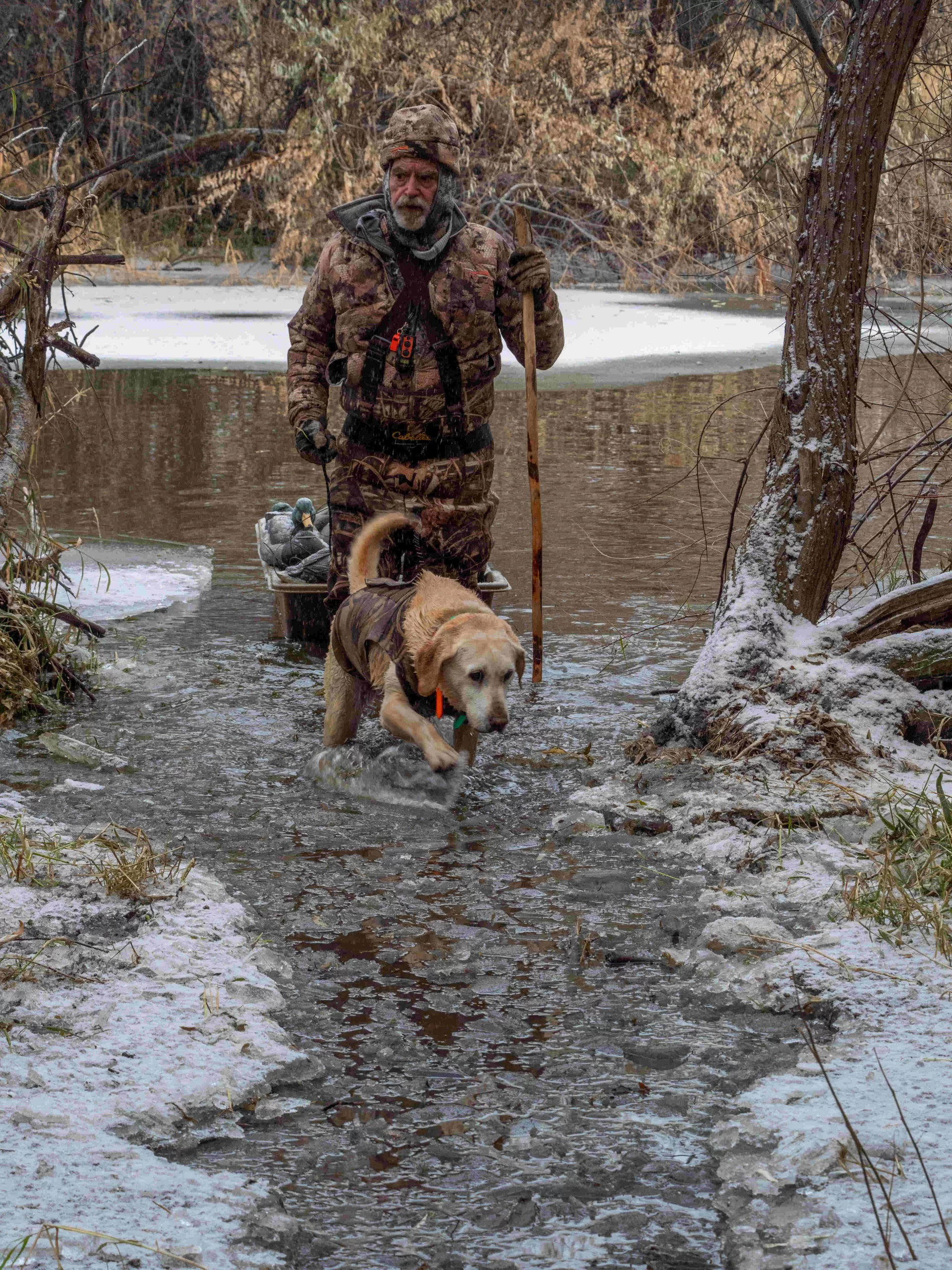WHY COLD AND MISERABLE CONDITIONS MAKE FOR BETTER DUCK HUNTING
By Don Thomas
THE SCIENCE BEHIND COLD WEATHER AND SOUND TRANSMISSION
The thing I notice first when the thermometer descends past 10-below here on the high plains isn’t the cold; it’s the acoustics. The physics are straightforward. Cold air is dense air, and molecules of nitrogen and oxygen transmit sound waves more efficiently when they’re packed tightly together. But to the observant outdoorsman, the complexity of the results defies the simplicity of their explanation. This morning, the sound of the spring creek babbling past the front of our makeshift blind offers an orchestral range of tone and timbre. Dry snow squeaks beneath the dog’s paws. The tinkle of frozen willow branches yielding to a browsing whitetail’s teeth sounds positively intimate even though the deer is over a hundred yards away. And when the first wave of mallards rises from the stubble fields two miles to the south, I can hear contented feeding chuckles long before I ever see the birds.
I have been told by responsible adults that hunting waterfowl in these conditions is a lunatic passion and they no doubt have a point. But they don’t know the local game the way I do. We live in an arid county on the cusp of the Pacific and Central Flyways. Absent abundant wetlands and a position in the middle of the great autumn flight paths, the first two months of duck season here are largely unproductive. That’s not to say I don’t hunt ducks then; I just don’t expect to kill a lot of them. Come December though, several thousand mallards will be wintering in the valley, feeding in grain fields and living on whatever open water they can find. When the mercury plummets and ice grips the rivers and reservoirs, they flock to spring fed creeks and ponds where the hunting can be spectacular. The Catch-22? If it’s warm enough to be comfortable in a blind, you’re not going to shoot any ducks.
Since the converse is true as well, Lori and I are bundled head to toe in an assortment of low, medium, and high-tech clothing adequate to stock a sporting good store. Canine companionship this morning comes from Rocky, the seasoned half of our kennel’s current yellow Lab duo. The temperature means nothing to him. Muzzle framed in a halo of icy whiskers, he’s busy scanning the sky for birds. We’ve loaded our guns – the chink of brass on steel still seems to be echoing from the hills – but there’s nothing to do but wait, providing an opportunity to reflect upon years of experience with the correlation between great wing-shooting and miserable weather.
WHY WATERFOWL HUNTING IN MISERABLE WEATHER WORKS
Even as a kid, I quickly realized that bluebird days are anathema to waterfowling. I still remember a long hike through the sagebrush to a large Columbia Basin pothole one clear, still October morning. Sunrise revealed a huge raft of puddle ducks and divers in the middle of the glassy lake, none closer than 200 yards from shore. Lifeless as decoys, they stayed there all morning. The few new arrivals all bypassed our spread to join the pajama party far out in the water. Down to shirtsleeves by mid-morning, my hunting partner and I finally circled the shore shouting and waving in a futile attempt to get some ducks airborne. The only shot we fired all morning came in a pointless attempt to flush the flock. Damn, but that was a gorgeous day.
The value of rain, snow, wind, and other forms of climactic misery is old news to seasoned waterfowl hunters, but bad weather has its place in upland cover too. Hot, dry scenting conditions can render even the best flushing dogs helpless. Weather concentrates upland game as well as waterfowl in predictable ways and there’s nothing like a foot of fresh snow to slow down running pheasants and chukar. Here in Montana, I’ve long been partial to the waning weeks of pheasant season, for reasons that have nothing to do with easy limits. I’m hunting educated survivors then, and a few cagey December roosters mean more to me than game vests full of naïve birds during the opening week. The dogs can run all day without overheating and so can I. Only a few fellow madmen are foolish enough to hunt pheasants in blizzards and they’re the folks I’m happy to run into out in the field anyway. Indian summer days early on make for nice pictures, but angry winter weather often makes for better bird hunting.
CLOTHING CHOICES FOR WATERFOWL HUNTING IN BAD WEATHER
Today’s new generation of outdoor clothing has made it easier to hunt birds in nasty weather and I certainly take advantage of modern synthetics and rain gear when I’m heading out into the worst of it. But as an incurable romantic, I’m not ready to forsake all of the old ways. I like the smell of wet wool; like a good whiff of pronghorn or moose, that aroma instantly evokes countless subliminal memories, most of them pleasant (at least after the fact). No matter how comfortable a good arsenal of modern outdoor wear can make you during the thick of the fray, I sometimes think we should chuck it all and go back to cotton long-johns, plaid wool shirts, and no-camo slickers just for old time’s sake. Granted, that kind of sentiment usually goes best at the end of the day when you’re dressed in fresh, dry clothing and sitting in front of a crackling fire with a glass in your hand.
No matter how you’re dressed, nasty wing-shooting weather can eventually cross the line from inconvenience to serious discomfort. One day years ago I was hunting the Cook Inlet tide flats in mid-October with my old Lab, Skykomish. The weather was beautiful when I took off from the dirt strip beside my house, with nothing serious ahead on the weather map. That’s a dicey time of year up north though and winter can arrive in a hurry… as it did a little after nine o’clock the following morning.
I was bundled up beside the decoys shooting nothing when I saw a wall of weather start to spill over the top of the Alaska Range behind me. I would have packed up and run for cover, but all the ducks that had been riding out the Indian summer deep in the Alaska Interior arrived right along with the storm. By the time I’d shot a limit of puddle ducks and Sky had retrieved them, ice was already forming on the decoys and I had gale winds and sleet in my face all the way back to the duck shack. But that was a gorgeous day too, at least once I’d reached the comfort of the oil stove.
HOW TO STAY WARM HUNTING IN COLD WEATHER

Before we progress to the dogs and their responses to cold weather, let me offer a brief review of proper protection from the elements based on years of experience in the field of wilderness medicine. Dressing properly to prevent hypothermia involves three layers of clothing. The inner wicking layer conducts heat-robbing moisture away from the body. Polypropylene or silk long underwear serves this purpose well. The middle insulating layer creates a thermal barrier to prevent loss of body heat to the environment. While newer synthetics accomplish this adequately, it’s still hard to beat wool, or even down as long as you’re sure you can keep it dry. The outer barrier layer protects everything inside from both wind and rain. Gore-Tex is an excellent choice if you’ll be exerting enough to work up a sweat, since it allows both inner layers to breathe. If you’re sitting still in a duck blind, an impervious fabric such as oilskin or rubberized cloth may keep you even more comfortable on rainy, windy days.
HUNTING DOGS IN COLD WEATHER
A retriever’s ability to thrive in such conditions – while plunging in and out of icy water, no less — seems utterly amazing, especially to non-hunters who sometimes wonder aloud how we can make our dogs do such things. There’s an easy answer to that question. We can’t make them hunt in cold weather; they’re too busy volunteering. Thanks to centuries of selective breeding back when our dogs’ ancestors were retrieving codfish from the North Atlantic, today’s retrievers come dressed naturally in water repellant, insulating coats that no human technology can rival. The problem isn’t making them go out on frigid mornings to fetch ducks; it’s making them come back home with you once you’ve shot your limit… or given up because you can’t stand the cold anymore.
Friends from lower latitudes sometimes wonder why I don’t dress my dogs in Neoprene vests on such cold weather outings, and I appreciate their concern. I also have experienced friends who do use vests on their dogs, but I’ve always taken the position that it’s hard to improve upon nature. Left alone, a Lab’s coat will shed water, fluff out, and begin to trap insulating pockets of air moments after a single shake at the end of a water retrieve. (Note how well a retriever’s coat, with its combination of guard hairs, under fur, and body oils, mimics the function of wicking, insulating, and barrier layers of clothing as described above.) And of course my dogs are conditioned to cold by habit as well as genetics. If I were taking a retriever from Mississippi to northern Alberta to hunt ducks over water, I would argue for some supplemental insulation. The same applies if I were asking a short haired breed like a GSP to handle the duck blind chores.

The only time I’ve ever seen any of my Labs act uncomfortably cold while hunting was when they were puppies. While still a youngster, Rocky whined so hard when we threatened to leave him behind one day that we relented and took him along despite the cold temperature. He spent the morning curled up on Lori’s lap while old Sonny handled all the retrieving chores. Young dogs have a high ratio of surface area to body mass, which promotes the loss of heat to the environment. Moral: if a pup objects to being left behind when you head out the door on a bitter day, leave the dog behind anyway.
Back down at the creek, Lori, Rocky, and I are shivering and waiting for Godot. Fully adapted to the cold and clad in the best insulation nature can provide, the dog looks happy as a pig in slop. He knows why we’re here and instinctively recognizes the mission as his raison d’etre. Lori seems less certain. She makes no bones about the fact that she’d rather shoot one shoveler on a nice day than a limit of sub-zero greenheads, but she’s too proud and stubborn to show the white feather. If anyone’s going to decide we’ve had enough and start picking up the decoys, it’s going to be me.
WHY SUBZERO TEMPERATURES ARE RELATIVELY SAFE TO HUNT IN
One important technical consideration amidst all this story-telling: 20-below may be damn cold but this isn’t the kind of weather that gets hunters in real trouble. Frigid temperatures like this are almost always the result of stable high pressure systems, which means little wind or moisture. You’re much more susceptible to hypothermia on a wet, windy day with temperatures in the 30’s than on a calm, clear one like this, no matter what the thermometer says. And that’s my rationalization for hanging on a little bit longer. I know we’ll survive; I just hope my marriage does too.
The face, feet, and hands always go first on days like this. Wool ski masks have the first concern covered, although frozen condensation from my breath has turned my beard into a bib of ice. Cold fingers have long been Lori’s downfall, but she’s learned to stuff her pockets with chemical hand-warmers and I can feel their heat against my side as we huddle together on the fallen log. Insulated waders and heavy socks notwithstanding, there isn’t much to do when your toes start to go numb except stamp your feet and hope the birds arrive before common sense prevails.
We’ve just reached that stage when Rocky glances sharply back over my shoulder. He’s too well trained to break, but the rules don’t say anything about excited whining. The noise of setting wings sounds like a jet engine spooling up for takeoff. Then the birds are circling the blocks and it’s time to start mentally isolating drakes from hens.
By pass-shooting standards, there isn’t much to the gunning here in the late season, when most birds fall at ranges I could reach comfortably with my fly rod. But the show is all mallards, and the goal is to kill five birds with green heads while leaving the ladies untouched. The epic part of the morning will belong to the dog soon enough.
“Take ‘em!” I whisper on the next pass and seconds later three drakes are tumbling as the rest of the flock claws its way back into the sky. Two of the fallen birds leave neat little entrance wounds in the snow bank across the creek while the third tumbles away on the dancing current. After handing my empty gun to Lori, I line Rocky up on the troublesome retrieve and he’s off in a spectacular geyser of spray.
Suddenly the cold just doesn’t feel cold anymore, and it’s another gorgeous day after all.




